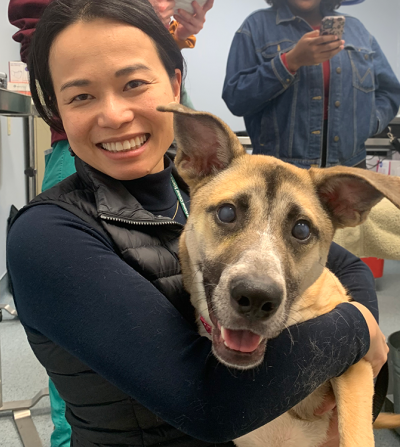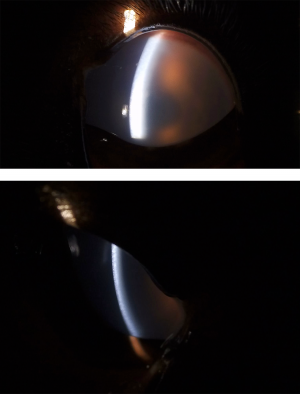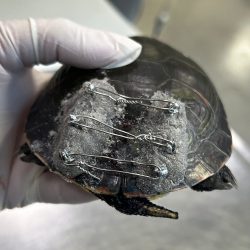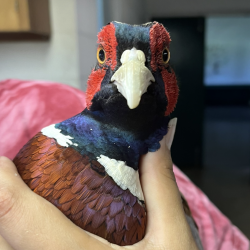
Claudia, a one-year-old stray dog at the Capital Area Humane Society, was about to go blind, and no one knew why.
Her eyes were turning cloudy and blue. They seemed painful, and the young dog appeared to be losing her vision.
At first, the shelter technicians suspected some sort of allergy, but the problem quickly worsened. Their best guess was “some sort of acute glaucoma,” but even then, the clinical signs didn’t quite match. Regardless, without a solution, Claudia was at risk of losing one or both eyes. Her caretakers were very worried.
Disease detecting
Meanwhile, a van full of ophthalmology residents and advanced clerkship students from the MSU College of Veterinary Medicine happened to be nearby for an educational excursion to a nature center, already equipped with all the specialized instruments. It was perfect timing. They dropped by the shelter to examine Claudia and provide a second opinion.
Dr. Keiko Miyadera, associate professor of ophthalmology, explains how they realized they weren’t dealing with typical glaucoma.
“The essence is, yes, her eyes looked like glaucoma at first, but we found that the eye pressures were normal. It was inflammation causing the cloudiness rather than the pressure increase of glaucoma,” she says.
Glaucoma is a progressive disease characterized by fluid buildup within the eyeball that damages the optic nerve. Glaucoma-affected eyes cannot properly drain fluid, so pressure builds until damage is done. It can be managed but not cured. Enucleation (removal of the eye) eventually becomes necessary to relieve discomfort.
But the MSU ophthalmology team didn’t find abnormal pressure in Claudia’s eyes. Another point in the wrong direction: her age.
“Claudia was too young for primary glaucoma to be likely,” says Miyadera. “It could have been secondary glaucoma with a massive inflammation of the eye, but our exam found that the inside of the eye was quiet. There was no clear evidence it could be a secondary glaucoma.”
So what was clouding Claudia’s eyes?

A rare complication
The MSU team dove into the detective work, looking backward through what was known of the former-stray’s medical history.
Meanwhile, the infectious panel testing came back. The results showed positive indicators of canine adenovirus 1 (CAV-1), the virus that causes infectious canine hepatitis. This was the tipping off-clue. In the past, the typical vaccine to prevent infectious canine hepatitis targeted CAV-1. However, nowadays, a newer and more comprehensive vaccine targets canine adenovirus 2 (CAV-2).
The shelter—as well as most veterinary clinics—uses the newer CAV-2 vaccine, but the animal control office that had taken Claudia from the street didn’t. And the vaccine that targets CAV-1 risks a rare complication that causes what’s commonly known as “blue eye,” which causes the cornea to swell and damage the corneal endothelium (the inner layer of the cornea, which keeps the cornea clear and transparent, allowing vision).
“We realized she had received the CAV-1 vaccine a few weeks prior, and the delayed timing of her clinical signs was indicative,” says Miyadera. “But we don’t often see blue eye as ophthalmologists because the Type-1 vaccine is used less commonly these days. But clinically, glaucoma and blue eye can look very similar from the outside.”
Following the eye exam by the MSU group, Claudia’s team could start her on the appropriate medication, and today Claudia is doing well. She was adopted from the shelter, and now lives happily with a family, cloudy-eyed no more.
Encountering a rare complication was educational for the students and residents that accompanied Miyadera.
“This was a good opportunity to learn to pay attention to what type of vaccine is given to patients,” she says. “If your clinic happens to use the vaccine that targets CAV-1 (component of DHLPP), there’s a small chance of 0.4 % that the vaccinated dog develops blue eye. Because of the universal use of the vaccine that targets CAV-2 (component of DA2PP), this has become a rare condition.
Fortunately, dogs can recover from blue eye without serious complications. However, since this condition can resemble more serious issues, such as glaucoma—which can lead to vision loss or even the loss of the eye—a thorough eye exam was essential. We’re glad were able to get an accurate diagnosis!”



